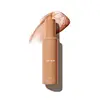What's inside
What's inside
 Key Ingredients
Key Ingredients

 Benefits
Benefits

 Concerns
Concerns

 Ingredients Side-by-side
Ingredients Side-by-side

Water
Skin ConditioningPanthenol
Skin ConditioningNiacinamide
SmoothingCaprylic/Capric Triglyceride
MaskingCoco-Caprylate/Caprate
EmollientMyristyl Myristate
EmollientPentylene Glycol
Skin ConditioningGlycerin
HumectantC13-15 Alkane
SolventSqualene
EmollientGlyceryl Stearate Citrate
EmollientButyrospermum Parkii Butter
Skin ConditioningCitrullus Lanatus Seed Oil
EmollientMangifera Indica Seed Butter
Skin ConditioningSimmondsia Chinensis Seed Oil
EmollientPolyglyceryl-3 Stearate
EmulsifyingPropanediol
SolventSaccharide Isomerate
HumectantSodium Polyacrylate
AbsorbentHydrogenated Lecithin
EmulsifyingCaprylyl Glycol
EmollientXanthan Gum
EmulsifyingTocopherol
AntioxidantEthylhexylglycerin
Skin ConditioningHexylene Glycol
EmulsifyingSclerotium Gum
Emulsion StabilisingLecithin
EmollientPullulan
Hydrolyzed Opuntia Ficus-Indica Flower Extract
AbrasivePantolactone
HumectantSodium Phytate
Silica
AbrasiveCeramide AP
Skin Conditioning1,2-Hexanediol
Skin ConditioningCitric Acid
BufferingSodium Citrate
BufferingBacillus Ferment
Skin ConditioningPhenoxyethanol
PreservativeWater, Panthenol, Niacinamide, Caprylic/Capric Triglyceride, Coco-Caprylate/Caprate, Myristyl Myristate, Pentylene Glycol, Glycerin, C13-15 Alkane, Squalene, Glyceryl Stearate Citrate, Butyrospermum Parkii Butter, Citrullus Lanatus Seed Oil, Mangifera Indica Seed Butter, Simmondsia Chinensis Seed Oil, Polyglyceryl-3 Stearate, Propanediol, Saccharide Isomerate, Sodium Polyacrylate, Hydrogenated Lecithin, Caprylyl Glycol, Xanthan Gum, Tocopherol, Ethylhexylglycerin, Hexylene Glycol, Sclerotium Gum, Lecithin, Pullulan, Hydrolyzed Opuntia Ficus-Indica Flower Extract, Pantolactone, Sodium Phytate, Silica, Ceramide AP, 1,2-Hexanediol, Citric Acid, Sodium Citrate, Bacillus Ferment, Phenoxyethanol
Hydrogenated Polyisobutene
EmollientIsopropyl Myristate
EmollientOlea Europaea Fruit Oil
MaskingVitis Vinifera Seed Oil
EmollientIsododecane
EmollientEthylene/Propylene/Styrene Copolymer
Mica
Cosmetic ColorantChondrus Crispus Extract
Skin ConditioningAloe Barbadensis Leaf Extract
EmollientHelianthus Annuus Seed Oil
EmollientTocopherol
AntioxidantCamellia Oleifera Seed Oil
Skin ConditioningOenothera Biennis Oil
EmollientSimmondsia Chinensis Seed Oil
EmollientCaprylic/Capric Triglyceride
MaskingButylene/Ethylene/Styrene Copolymer
Pentaerythrityl Tetra-Di-T-Butyl Hydroxyhydrocinnamate
AntioxidantPhenoxyethanol
PreservativeCI 77491
Cosmetic ColorantCI 77891
Cosmetic ColorantHydrogenated Polyisobutene, Isopropyl Myristate, Olea Europaea Fruit Oil, Vitis Vinifera Seed Oil, Isododecane, Ethylene/Propylene/Styrene Copolymer, Mica, Chondrus Crispus Extract, Aloe Barbadensis Leaf Extract, Helianthus Annuus Seed Oil, Tocopherol, Camellia Oleifera Seed Oil, Oenothera Biennis Oil, Simmondsia Chinensis Seed Oil, Caprylic/Capric Triglyceride, Butylene/Ethylene/Styrene Copolymer, Pentaerythrityl Tetra-Di-T-Butyl Hydroxyhydrocinnamate, Phenoxyethanol, CI 77491, CI 77891
 Reviews
Reviews

Ingredients Explained
These ingredients are found in both products.
Ingredients higher up in an ingredient list are typically present in a larger amount.
This ingredient is an emollient, solvent, and texture enhancer. It is considered a skin-softener by helping the skin prevent moisture loss.
It helps thicken a product's formula and makes it easier to spread by dissolving clumping compounds.
Caprylic Triglyceride is made by combining glycerin with coconut oil, forming a clear liquid.
While there is an assumption Caprylic Triglyceride can clog pores due to it being derived from coconut oil, there is no research supporting this.
Learn more about Caprylic/Capric TriglyceridePhenoxyethanol is a preservative that has germicide, antimicrobial, and aromatic properties. Studies show that phenoxyethanol can prevent microbial growth. By itself, it has a scent that is similar to that of a rose.
It's often used in formulations along with Caprylyl Glycol to preserve the shelf life of products.
This oil comes from the seeds of the desert shrub called Jojoba. It is more commonly known as jojoba oil, a non-comedogenic oil.
Jojoba oil does not contain fragrance and has many fatty-acids, making it a great soothing ingredient.
It also contains Vitamin E, a great moisturizing ingredient. Vitamin E is also an antioxidant and protects your skin against oxidative damage.
This ingredient humectant properties, meaning it helps draw moisture from the air. This helps keep your skin hydrated.
While jojoba has antibacterial properties, it is only able to kill some strains of bacteria.
Studies also show it helps in wound healing. In fact, Indigenous cultures have used jojoba as a moisturizer and to help treat burns for centuries.
Fun fact: Jojoba oil similar to natural human skin sebum, so it has a great effect on dry skin. It is also promising with helping to regulate sebum production.
Due to its fatty acid content, Jojoba oil may not be fungal acne safe. We recommend speaking with a professional if you have any concerns.
Learn more about Simmondsia Chinensis Seed OilTocopherol (also known as Vitamin E) is a common antioxidant used to help protect the skin from free-radicals and strengthen the skin barrier. It's also fat soluble - this means our skin is great at absorbing it.
Vitamin E also helps keep your natural skin lipids healthy. Your lipid skin barrier naturally consists of lipids, ceramides, and fatty acids. Vitamin E offers extra protection for your skin’s lipid barrier, keeping your skin healthy and nourished.
Another benefit is a bit of UV protection. Vitamin E helps reduce the damage caused by UVB rays. (It should not replace your sunscreen). Combining it with Vitamin C can decrease sunburned cells and hyperpigmentation after UV exposure.
You might have noticed Vitamin E + C often paired together. This is because it is great at stabilizing Vitamin C. Using the two together helps increase the effectiveness of both ingredients.
There are often claims that Vitamin E can reduce/prevent scarring, but these claims haven't been confirmed by scientific research.
Learn more about Tocopherol